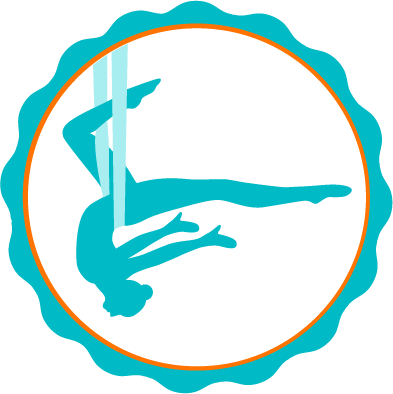Aerial Yoga vs. Traditional Yoga: Whats the Difference?
21 Feb, 2022
By Admin

Yoga has evolved in many ways over the centuries, and today, one of the most innovative adaptations of the traditional practice is aerial yoga. While both traditional and aerial yoga share the same foundational principles of mindfulness, balance, and flexibility, aerial yoga introduces a unique element that sets it apart: the use of a suspended hammock or aerial silk.
In this blog, we’ll dive into the key differences between aerial yoga and traditional yoga, how each benefits the body and mind, and when you might want to choose one practice over the other.
Traditional yoga encompasses a variety of practices, but the most widely practiced forms are Hatha, Vinyasa, and Ashtanga. These styles focus on physical postures (asanas), breathwork (pranayama), and meditation, each aiming to strengthen the body, calm the mind, and enhance overall well-being.
In traditional yoga, practitioners perform poses on a mat, grounding themselves to the earth. The practice emphasizes alignment, breathing techniques, and the flow of energy throughout the body. It can be gentle and restorative (like in Yin or Hatha yoga) or more dynamic and challenging (as in Vinyasa or Power Yoga).
Whether you’re doing a slow-paced class or a more rigorous one, the physical benefits of traditional yoga include increased strength, flexibility, and mental clarity.
Aerial yoga is a modern fusion of traditional yoga, acrobatics, and Pilates, performed with the aid of a hammock or fabric sling that’s suspended from the ceiling. This hammock serves as a prop that can be used for support, allowing you to stretch deeper into poses, explore inversion therapy, and achieve more fluid movement.
Aerial yoga is unique because it introduces the element of suspension – the feeling of weightlessness that can enhance flexibility, decompress the spine, and make inversions (like headstands and handstands) more accessible. The hammock helps practitioners achieve poses they may not typically be able to do on the floor, especially deep backbends or stretches that require support.
Aerial yoga combines strength, flexibility, and mental focus, while also focusing on playfulness and the therapeutic aspects of inversion, making it a fun and unique way to experience the benefits of yoga.
Traditional Yoga: In traditional yoga, practitioners rely solely on their body and the support of the mat to perform poses. The mat helps provide grounding, stability, and traction during the practice.
Aerial Yoga: The hammock in aerial yoga acts as both a prop and support. It can assist in deepening stretches and improving alignment by suspending parts of the body in the air. It allows practitioners to engage in poses that might otherwise be challenging or impossible on a mat, such as inversions and spinal decompressions.
Traditional Yoga: While traditional yoga does include inversions (such as shoulder stands or downward dog), they are usually performed on the floor or with the body supported by the ground. Inversions are beneficial for circulation and overall energy flow, but they can be difficult or uncomfortable for some practitioners.
Aerial Yoga: Aerial yoga makes inversions more accessible by offering the support of the hammock. Hanging upside down or in gravity-defying poses can improve circulation, increase flexibility, relieve pressure from the spine, and even help with conditions like lower back pain. For many practitioners, inversions in aerial yoga are easier to perform and more enjoyable than traditional floor-based inversions.
Traditional Yoga: Traditional yoga requires significant core strength, especially in poses like plank, boat pose, or warrior. These poses engage the abdominals and obliques to stabilize the body during movement.
Aerial Yoga: In aerial yoga, the hammock forces the practitioner to engage their core even more intensely. Balancing in the hammock or transitioning between poses requires greater control and stabilization, making it a fantastic way to strengthen the core. Additionally, the hammock adds an extra element of challenge to core-based poses.
Traditional Yoga: Traditional yoga requires that the practitioner has a certain level of flexibility and strength to perform poses effectively. While modifications can be made, some poses may be difficult for beginners, seniors, or people with physical limitations.
Aerial Yoga: The hammock in aerial yoga provides extra support, making it accessible to a broader range of people. Beginners, those with physical limitations, or individuals recovering from injuries can rely on the hammock to assist them in performing poses and stretches that they may not otherwise be able to do on the ground. It also allows for safer inversion practices, which might be intimidating in traditional yoga.
Traditional Yoga: Traditional yoga emphasizes mindfulness, breathing techniques, and meditation. The practice encourages practitioners to connect deeply with their body and breath, often in a calm, grounded, and peaceful setting.
Aerial Yoga: While aerial yoga also promotes mindfulness, it adds an element of fun and playfulness. The unique nature of suspension may bring a sense of childlike wonder and joy to the practice, allowing people to let go of stress, release tension, and focus on feeling weightless and free. However, aerial yoga still incorporates meditation and breathwork for balance and mental clarity.
Traditional Yoga: The intensity of traditional yoga can vary greatly depending on the style. For example, Vinyasa or Power Yoga is more fast-paced and physically demanding, while Yin or Hatha Yoga is slower and more restorative.
Aerial Yoga: Aerial yoga tends to be dynamic and can feel like a fusion of strength training, Pilates, and traditional yoga. It’s a full-body workout that challenges flexibility, core strength, and balance. Although aerial yoga can be intense, it can also be gentler and more restorative if practiced in a slower, mindful way, focusing on stretching and relaxation.
Choose Aerial Yoga if:
Choose Traditional Yoga if:
Both aerial yoga and traditional yoga have their unique benefits and appeal to different people depending on their goals, fitness level, and preferences. If you’re new to yoga, aerial yoga might provide a fun and supportive entry point, offering a playful approach to mastering poses. On the other hand, if you’re looking for a grounded, meditative practice with an emphasis on self-awareness, traditional yoga might be a better fit.
Ultimately, many people find that incorporating both types of yoga into their routine provides a well-rounded approach to physical and mental well-being. Whether you’re hanging upside down in the hammock or grounded in savasana, both forms of yoga offer powerful tools for cultivating a deeper mind-body connection.
Which practice resonates with you more? Let us know in the comments below!
Aerial Yoga vs. Traditional Yoga: What’s the Difference?
What is Traditional Yoga?
What is Aerial Yoga?
Key Differences Between Aerial Yoga and Traditional Yoga
The Use of the Hammock
Inversions and Spinal Decompression
Core Strength
Accessibility and Support
Mental Focus and Mindfulness
Intensity and Pacing
When to Choose Aerial Yoga vs. Traditional Yoga
Conclusion: Which One is Right for You?
